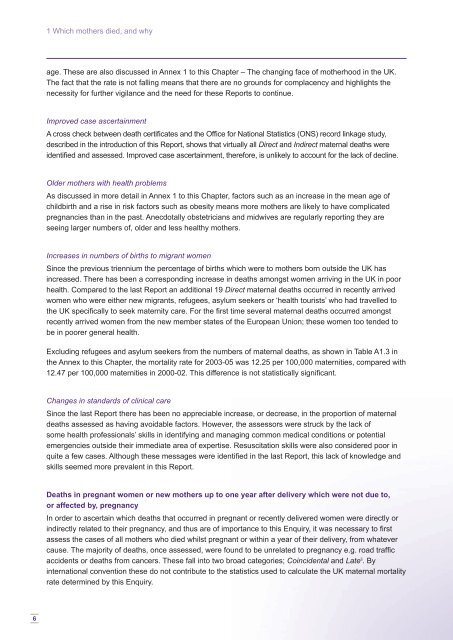Saving Mothers' Lives: - Public Health Agency for Northern Ireland
Saving Mothers' Lives: - Public Health Agency for Northern Ireland
Saving Mothers' Lives: - Public Health Agency for Northern Ireland
Create successful ePaper yourself
Turn your PDF publications into a flip-book with our unique Google optimized e-Paper software.
6<br />
1 Which mothers died, and why<br />
age. These are also discussed in Annex 1 to this Chapter – The changing face of motherhood in the UK.<br />
The fact that the rate is not falling means that there are no grounds <strong>for</strong> complacency and highlights the<br />
necessity <strong>for</strong> further vigilance and the need <strong>for</strong> these Reports to continue.<br />
Improved case ascertainment<br />
A cross check between death certifi cates and the Offi ce <strong>for</strong> National Statistics (ONS) record linkage study,<br />
described in the introduction of this Report, shows that virtually all Direct and Indirect maternal deaths were<br />
identifi ed and assessed. Improved case ascertainment, there<strong>for</strong>e, is unlikely to account <strong>for</strong> the lack of decline.<br />
Older mothers with health problems<br />
As discussed in more detail in Annex 1 to this Chapter, factors such as an increase in the mean age of<br />
childbirth and a rise in risk factors such as obesity means more mothers are likely to have complicated<br />
pregnancies than in the past. Anecdotally obstetricians and midwives are regularly reporting they are<br />
seeing larger numbers of, older and less healthy mothers.<br />
Increases in numbers of births to migrant women<br />
Since the previous triennium the percentage of births which were to mothers born outside the UK has<br />
increased. There has been a corresponding increase in deaths amongst women arriving in the UK in poor<br />
health. Compared to the last Report an additional 19 Direct maternal deaths occurred in recently arrived<br />
women who were either new migrants, refugees, asylum seekers or ‘health tourists’ who had travelled to<br />
the UK specifi cally to seek maternity care. For the fi rst time several maternal deaths occurred amongst<br />
recently arrived women from the new member states of the European Union; these women too tended to<br />
be in poorer general health.<br />
Excluding refugees and asylum seekers from the numbers of maternal deaths, as shown in Table A1.3 in<br />
the Annex to this Chapter, the mortality rate <strong>for</strong> 2003-05 was 12.25 per 100,000 maternities, compared with<br />
12.47 per 100,000 maternities in 2000-02. This difference is not statistically signifi cant.<br />
Changes in standards of clinical care<br />
Since the last Report there has been no appreciable increase, or decrease, in the proportion of maternal<br />
deaths assessed as having avoidable factors. However, the assessors were struck by the lack of<br />
some health professionals’ skills in identifying and managing common medical conditions or potential<br />
emergencies outside their immediate area of expertise. Resuscitation skills were also considered poor in<br />
quite a few cases. Although these messages were identifi ed in the last Report, this lack of knowledge and<br />
skills seemed more prevalent in this Report.<br />
Deaths in pregnant women or new mothers up to one year after delivery which were not due to,<br />
or affected by, pregnancy<br />
In order to ascertain which deaths that occurred in pregnant or recently delivered women were directly or<br />
indirectly related to their pregnancy, and thus are of importance to this Enquiry, it was necessary to fi rst<br />
assess the cases of all mothers who died whilst pregnant or within a year of their delivery, from whatever<br />
cause. The majority of deaths, once assessed, were found to be unrelated to pregnancy e.g. road traffi c<br />
accidents or deaths from cancers. These fall into two broad categories; Coincidental and Lateii . By<br />
international convention these do not contribute to the statistics used to calculate the UK maternal mortality<br />
rate determined by this Enquiry.



